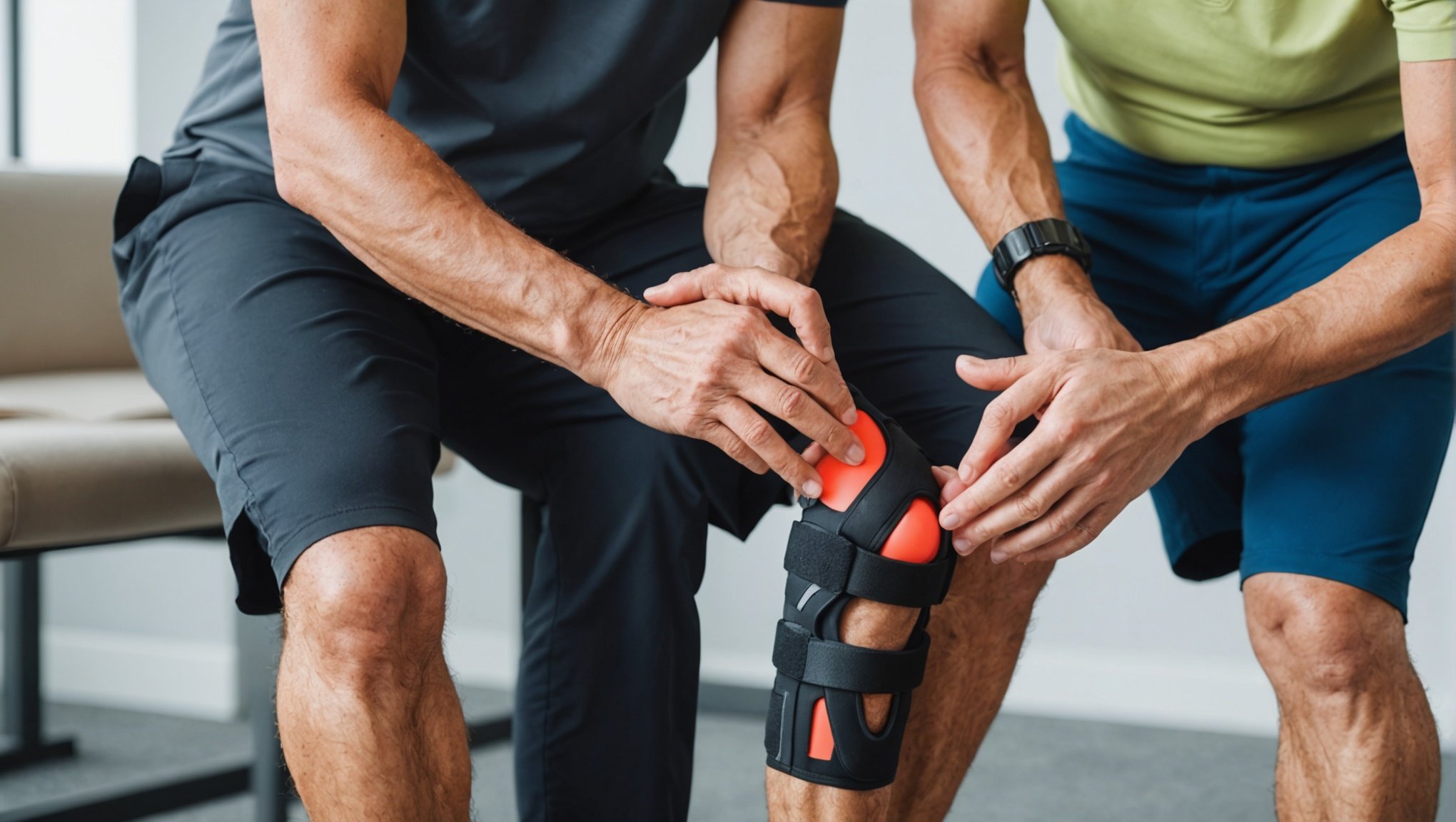Knee arthritis can significantly impact mobility and quality of life. Fortunately, innovative non-invasive therapies are emerging, offering hope for effective pain management and improved function. Recent breakthroughs in techniques such as regenerative medicine, advanced physical therapy, and digital health solutions have opened up new avenues for treatment. This comprehensive overview explores the latest advancements in non-invasive options that provide relief, empowering individuals to reclaim their active lifestyles. Discover how these therapies can transform your knee health today!
Overview of Knee Arthritis and Its Impact
Knee arthritis is a common condition affecting millions worldwide.
In parallel : Unlocking the secrets of psychology: transform your life today
Definition and Types of Knee Arthritis
Knee arthritis is a chronic condition where the cartilage in the knee joint wears down, leading to pain and stiffness. There are several types, with osteoarthritis being the most prevalent, often resulting from wear and tear. Rheumatoid arthritis is another type, where the immune system attacks joint tissues, causing inflammation.
Prevalence and Demographics Affected
Knee arthritis is widespread, especially among the elderly. According to studies, it affects approximately 10% of men and 13% of women over the age of 60. Younger individuals can also be impacted due to injuries or genetic factors. Non-invasive treatments are increasingly sought after as they offer relief without surgery.
In parallel : 10 powerful psychology hacks to change your life now
Common Symptoms and Challenges Faced by Patients
Patients often experience joint pain, swelling, and decreased mobility. These symptoms can significantly hinder daily activities and reduce quality of life. Managing knee arthritis involves understanding these challenges and exploring effective non-invasive treatments.
- Pain and stiffness
- Reduced mobility
- Swelling and inflammation
Addressing these issues with appropriate treatments can improve patient outcomes and enhance overall well-being.
Latest Breakthroughs in Non-Invasive Therapies
Explore the forefront of knee arthritis treatment innovations.
Overview of Recent Technological Advancements
The landscape of non-invasive therapies for knee arthritis is rapidly evolving. Recent innovations have led to the development of treatments that minimize discomfort and enhance recovery. For instance, radiofrequency ablation and platelet-rich plasma (PRP) injections are gaining traction. These therapies target pain and inflammation at the source, offering patients new hope.
Breakthrough Therapies Gaining Traction
As research progresses, several treatment advancements have emerged. Stem cell therapy is a promising area, where regenerative cells are used to repair damaged tissues. Additionally, viscosupplementation involves injecting lubricating fluid into the knee joint, improving mobility and reducing pain. These innovations are reshaping how knee arthritis is managed.
- Radiofrequency Ablation
- Platelet-Rich Plasma (PRP) Injections
- Stem Cell Therapy
- Viscosupplementation
Importance of Ongoing Research and Development
Continuous research and development are crucial for further advancements. The medical community is focused on refining these therapies to enhance their effectiveness and accessibility. As more innovations emerge, they hold the potential to revolutionize treatment options, offering patients relief without the need for surgery.
Physical Therapy Techniques and Their Benefits
Physical therapy offers promising solutions for knee arthritis management.
Overview of Effective Physical Therapy Modalities
Physical therapy is a cornerstone in the rehabilitation of knee arthritis, utilizing a range of modalities to enhance pain management and functionality. Techniques such as manual therapy, hydrotherapy, and electrotherapy are commonly employed. These methods aim to reduce pain, improve joint mobility, and strengthen surrounding muscles. By tailoring exercises to individual needs, therapists can significantly improve outcomes.
Benefits of Tailored Exercise Programs
Customized exercise programs are pivotal in physical therapy. They focus on pain management and rehabilitation, helping patients regain strength and flexibility. A well-structured program can alleviate symptoms and prevent further joint damage. Benefits include:
- Improved range of motion
- Enhanced muscle strength
- Reduced pain and stiffness
Such programs empower patients to actively participate in their recovery, leading to better long-term results.
Role of Physical Therapists in Patient Recovery
Physical therapists play a crucial role in guiding patients through their rehabilitation journey. They assess individual needs and develop exercises that target specific issues. Their expertise in pain management ensures that patients receive the most effective care, facilitating a smoother recovery process. By fostering a supportive environment, therapists encourage patients to stay committed to their rehabilitation goals.
Injection Therapies: Options and Efficacy
Exploring diverse injection therapies for knee arthritis relief.
Types of Injection Therapies Available
Injection therapies offer promising solutions for managing knee arthritis. Among the most common are corticosteroids and hyaluronic acid injections. Corticosteroids are known for their rapid anti-inflammatory effects, providing quick relief from pain and swelling. On the other hand, hyaluronic acid acts as a lubricant, enhancing joint movement and cushioning the knee. These treatments are tailored to individual needs, offering personalized care options.
Clinical Studies on Effectiveness and Safety
Numerous clinical studies have evaluated the effectiveness and safety of these injection therapies. Research indicates that corticosteroids can significantly reduce pain in the short term, while hyaluronic acid may offer longer-lasting benefits. Safety profiles for both therapies are generally favorable, with minimal adverse effects reported. These findings support their use as viable options in knee arthritis management.
Patient Experiences and Testimonials
Patient experiences with injection therapies vary, but many report positive outcomes. Testimonials highlight improvements in mobility and a reduction in pain. Here are some common sentiments:
- Rapid relief with corticosteroids
- Improved joint function with hyaluronic acid
- Enhanced quality of life post-treatment
These insights underscore the potential benefits of injection therapies in alleviating knee arthritis symptoms.
Alternative Medicine Approaches
Exploring complementary treatments for knee arthritis relief.
Overview of Popular Alternative Treatments
Alternative medicine offers various complementary treatments for managing knee arthritis. These approaches emphasize a more holistic care strategy, aiming to treat the whole person rather than just symptoms. Popular methods include acupuncture, herbal supplements, and massage therapy. Each of these treatments is designed to alleviate pain and improve joint function through natural means.
Evidence Supporting or Refuting Their Efficacy
The effectiveness of alternative medicine in knee arthritis varies. Some studies suggest that acupuncture can reduce pain and improve mobility, although results are mixed. Herbal supplements like turmeric and ginger have shown potential anti-inflammatory effects, yet their efficacy remains under investigation. Massage therapy is often praised for its ability to relieve tension and enhance circulation, though scientific backing is limited.
Integrating Alternative Therapies with Traditional Medicine
Combining alternative medicine with traditional treatments can offer a balanced approach to knee arthritis management. Patients often find that integrating these therapies enhances overall well-being. For instance, using acupuncture alongside physical therapy may optimize pain relief. Holistic care encourages patients to explore diverse options, fostering a comprehensive treatment plan.
- Acupuncture: Mixed results, potential pain relief
- Herbal supplements: Anti-inflammatory potential
- Massage therapy: Enhances circulation, limited studies
These approaches provide additional avenues for those seeking non-conventional solutions.
Impact of Lifestyle Changes on Knee Arthritis
Adapting lifestyle habits can significantly influence knee arthritis management.
Importance of Weight Management in Treatment
Maintaining a healthy weight is crucial for managing knee arthritis, as excess weight adds stress to knee joints. Studies show that losing even a small percentage of body weight can lead to significant reductions in pain and improved mobility. Weight management not only alleviates symptoms but also slows disease progression. Patients are encouraged to adopt a balanced diet and regular exercise routine to achieve sustainable weight loss.
Dietary Recommendations for Knee Health
A nutritious diet plays a vital role in supporting knee health. Incorporating anti-inflammatory foods such as leafy greens, nuts, and fatty fish can help reduce joint inflammation. Additionally, avoiding processed foods and sugars may further decrease inflammation levels. Here are some dietary tips:
- Increase omega-3 intake (e.g., salmon, chia seeds)
- Consume antioxidants (e.g., berries, spinach)
- Limit processed foods and sugars
Role of Regular Exercise and Mobility in Managing Symptoms
Regular exercise is essential for maintaining joint function and reducing stiffness. Activities like swimming, cycling, and yoga are excellent for enhancing mobility without putting undue stress on the knees. Exercise helps strengthen muscles around the knee, providing better support and reducing pain. Emphasizing flexibility and strength training can lead to improved quality of life for those with knee arthritis.
Accessibility and Affordability of Non-Invasive Treatments
Understanding the landscape of treatment accessibility and financial considerations.
Overview of Access to Non-Invasive Therapies
Access to non-invasive treatments for knee arthritis is crucial for patient care. However, barriers such as geographical location and availability of specialized clinics often limit accessibility. Rural areas may lack healthcare facilities offering advanced non-invasive therapies, forcing patients to travel long distances.
Barriers Patients Face in Receiving Treatment
Patients encounter significant barriers when seeking knee arthritis treatments. These include high healthcare costs and limited insurance coverage. Many insurance plans do not fully cover innovative therapies like platelet-rich plasma (PRP) injections, leaving patients to shoulder substantial expenses. Additionally, the approval process for coverage can be lengthy and complex.
- Geographical limitations
- High out-of-pocket expenses
- Complex insurance requirements
Insurance Coverage and Financial Assistance Options
Insurance coverage plays a pivotal role in the affordability of treatments. While some plans offer partial coverage for non-invasive options, others require patients to pay out-of-pocket. Exploring financial assistance programs can alleviate these costs. Organizations and charities sometimes provide support to those unable to afford treatment, ensuring broader accessibility for essential care.
In conclusion, understanding these factors and exploring available options can empower patients to make informed decisions regarding their treatment journey.
Future Directions in Non-Invasive Treatments for Knee Arthritis
Exploring the horizon of knee arthritis management innovations.
Anticipated Advancements in Treatment Technologies
The future of non-invasive treatments for knee arthritis is promising, with anticipated advancements in treatment technologies set to revolutionize patient care. Emerging therapies focus on enhancing precision and efficacy. For instance, nanotechnology is being explored to deliver targeted drug therapies directly to affected areas, minimizing side effects. Another area of interest is bioprinting, which could potentially be used for regenerating damaged cartilage.
Importance of Patient-Centered Research
Patient-centered research is crucial in developing effective therapies. By focusing on patient experiences and outcomes, researchers can tailor treatments to meet individual needs. This approach ensures that innovations are not only technologically advanced but also practically beneficial. For example, incorporating patient feedback in the design of wearable devices can enhance compliance and effectiveness.
Potential for Personalized Medicine in Knee Arthritis Management
The potential for personalized medicine in knee arthritis management is vast. With advancements in genomics and biomarker research, treatments can be customized to suit genetic profiles. This personalized approach promises more effective management of knee arthritis symptoms, reducing trial-and-error in treatment selection.
- Nanotechnology
- Bioprinting
- Genomics
- Biomarker research











